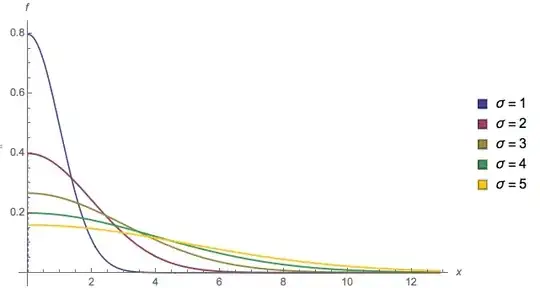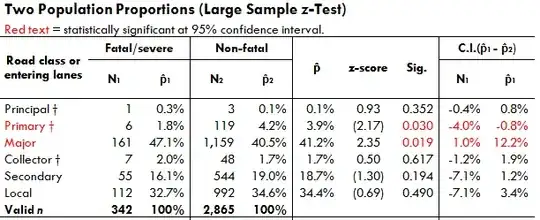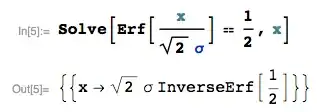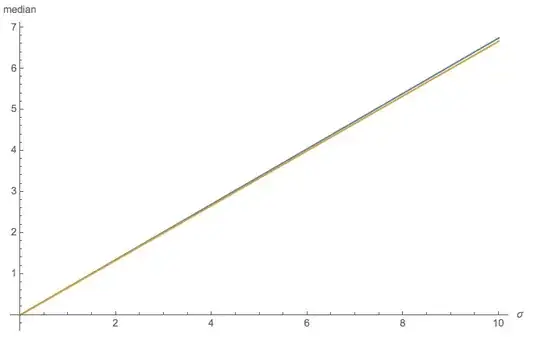The constant $2/3\approx 0.66667$ in the question approximates $\Phi^{-1}(3/4) \approx 0.67449$ (the third quartile of the standard Normal distribution) as $n$ grows large. See equation $(3)$ below.
To avoid the nuisance of dealing with medians of even batches of numbers, let's focus on odd batches with $2n+1$ numbers, for which the middle value (the median) is the $n+1^\text{st}$ largest or smallest. When those numbers are assumed identically and independently distributed according to some continuous distribution $F$ (with density $F^\prime=f$), their median is a random variable with density
$$F_{2n+1;n}(x) = \binom{2n+1}{n,\,1,\,n}F^n(x) (1-F(x))^n f(x).\tag{1}$$
(The multinomial coefficient can be computed as $\binom{2n+1}{n,\,1,\,n} = (2n+1)!/(n!1!n!)$.)
Now suppose the numbers are the absolute values of random variables having a continuous distribution $\Phi$ symmetric around $0$. The distribution of the absolute value of such an $X$ is, by definition,
$$\eqalign{F(x) &= \Pr(|X| \le x) = \Pr(-x \le X \le x) \\&= \Pr(X \le x) - \Pr(X \lt -x) \\&= \Phi(x) - \Phi(-x) = 1-2\Phi(-x).}$$
Writing $\phi(x)$ for $\frac{d}{dx}\Phi(x)$, its density therefore is
$$f(x) = \frac{d}{dx}\left(1-2\Phi(-x)\right) = 2\phi(-x) = 2\phi(x).$$
Plug this into $(1)$ to obtain the density of the median of $|X_1|, |X_2|, \ldots, |X_{2n+1}|$,
$$F_{2n+1;n}(x) = \binom{2n+1}{n,\,1,\,n}(1-2\Phi(-x))^n(2\Phi(-x))^n 2 \phi(x).\tag{2}$$
For the standard Normal distribution $\Phi$, the expectation of $(2)$--which is the integral of $xF_{2n+1;n}(x)$ from $0$ to $\infty$--has a convenient closed form only when $n=0$. For larger $n$ it can readily be numerically integrated, though, because the distribution of the median rapidly approaches Normality and its limiting mean must be the median of $|X|$ itself. That median $m_{|X|}$ satisfies
$$1/2 = F_{2n+1;n}(m_{|X|}) = 1 - 2\Phi(-m_{|X|}),$$
with the unique solution
$$m_{|X|} = -\Phi^{-1}(1/4) = \Phi^{-1}(3/4),$$
the upper quartile of the standard Normal distribution.
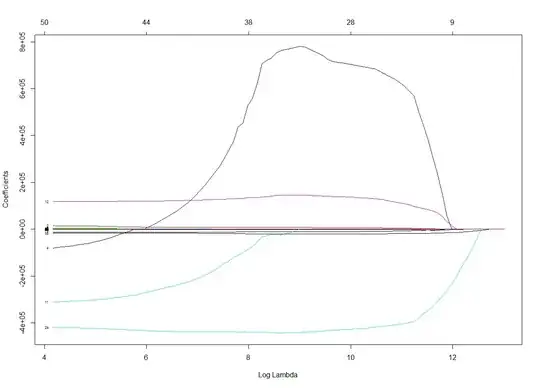
Computations based on $n=0, 1, \ldots, 129$ suggest a nice approximation. Let's compare the expectation, given by
$$E(n) = \mathbb{E}(\operatorname{median}(|X_1|,\ldots,|X_{2n+1}|) = \int_0^\infty x F_{2n+1;n}(x)dx$$
to its limiting value
$$\lim_{n\to\infty} E(n) = m_{|X|} = \Phi^{-1}(3/4).$$
The difference is approximately $\delta(n) = 0.1043642189 / (n+1)$; that is,
$$E(n) \approx \Phi^{-1}(3/4) + \frac{0.1043642189}{n+1}.\tag{3}$$
As a demonstration, here is a plot of $1/(E(n) - \Phi^{-1}(3/4))$ against $n$ for $n=0$ through $129$. The superimposed red line plots $1/\delta=9.58183(n+1)$ against $n$; the agreement is excellent.
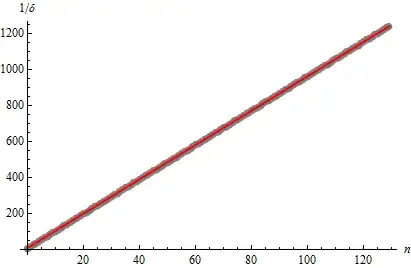
Here are some of the residuals in this approximation.
$$
\begin{array}{rlll}
n & E(n) & \text{Approximation} & \text{Difference} \\
\hline \\
0 & 0.797885 & 0.726672 & -0.0712127 \\
10 & 0.684191 & 0.683187 & -0.0010038 \\
20 & 0.679519 & 0.679234 & -0.0002850\\
30 & 0.677884 & 0.677751 & -0.0001324 \\
40 & 0.677051 & 0.676975 & -0.0000762 \\
50 & 0.676546 & 0.676497 & -0.0000494 \\
60 & 0.676208 & 0.676173 & -0.0000347 \\
70 & 0.675965 & 0.675939 & -0.0000256 \\
80 & 0.675782 & 0.675762 & -0.0000197 \\
90 & 0.675640 & 0.675624 & -0.0000156 \\
100 & 0.675526 & 0.675513 & -0.0000127 \\
110 & 0.675432 & 0.675422 & -0.0000105 \\
120 & 0.675354 & 0.675345 & -0.0000089 \\
\hline
400 & 0.6747502 & 0.6747500 & -0.0000002 \\
1000 & 0.67459404 & 0.67459401 & -0.00000003 \\
10,000 & 0.6745001858 & 0.6745001856 & -0.0000000003
\end{array}$$
(The final value may be imprecise.) The last three lines are extrapolations of this formula to much higher values of $n$: that they work so well suggests the constant $0.1043642189$ is accurate.
Higher-order approximations can readily be worked out.
Finally, $\sigma$ is merely a scale factor for the Normal distribution and thereby will multiply $E(n)$ when the underlying distribution is Normal$(0,\sigma)$.

